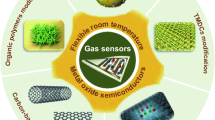Abstract
Gas sensors have been fabricated based on field ionization from titanium oxide nanotubes grown on titanium foil. Ordered nanaotube arrays of titanium oxides were grown by the anodization method. We measured breakdown voltages and discharge currents of the device for various gases. Our gas ionization sensors (GIS) presented good sensitivity, selectivity, and short response time. The GISs based on TiO2 nanotube arrays showed lower breakdown voltage, higher discharge current, and good selectivity. An excellent response observed for Ar compared to other gases. Besides, by introducing 2 % CO and 4 % H2 to N2 flow gas, the amount of breakdown voltage shifts about 20 and 70 volts to the lower values, respectively. The GIS works at room temperature and has the ability of detect inert gases with high stability and good linearity. Besides, short response time of about 1 second for the GISs based on TiO2 nanotube arrays makes them excellent for gas sensing applications. Sharp edges of the nanotubes, through enhancing the applied electric field, reduce operating voltage to the reasonable values and power consumption.







Similar content being viewed by others
References
I. Sayago, M.d.C. Horrillo, S. Baluk, M. Aleixandre, M.J. Fernandez, L. Ares, M. Garcia, J.P. Santos, J. Gutierrez, Detection of toxic gases by a tin oxide multi sensor. IEEE Sens. J. 2(5) (2002)
L.M. Cukrov, P.G. McCormick, K. Galatsis, W. Wlodarski, Micro characterization and gas sensing properties of mechanochemically processed nanosized iron-doped SnO2 sensors. Proc. IEEE 1, 443–447 (2002)
A. Chowdhuri, V. Gupta, K. Sreenivas, Enhanced catalytic activity of ultra-thin CuO islands on SnO2 films for fast response H2S gas sensors. Sensors. Proc. IEEE 1, 430–434 (2002)
D.S. Lee, D.D. Lee, S.W. Ban, M. Lee, Y.T. Kim, SnO2 gas sensing array for combustible and explosive gas leakage recognition. IEEE Sens. J. 2(3) (2002)
E. Kanazawa, G. Sakai, K. Shimanoe, Y. Kanmura, Y. Teraoka, N. Miura, N. Yamazoe, Metal oxide semiconductor N2O sensor for medical use. Sens. Actuators B 77, 72–77 (2001)
J. Huang, J. Wang, C. Gu, K. Yu, F. Meng, J. Liu, A novel highly sensitive gas ionization sensor for ammonia detection. Sens. Actuators A 150, 218–223 (2009)
Z. Hou, J. Wu, W. Zhou, X. Wei, D. Xu, Y. Zhang, B. Cai, A MEMS-based ionization gas sensor using carbon nanotubes. IEEE Trans. Electron Devices 54(6), 1545–1548 (2007)
H.S. Sim, S.P. Lau, L.K. Ang, M. Tanemura, K. Yamaguchi, Multi-purpose ionization gas sensing devices using carbon nanofibers on plastic substrates. Diam. Relat. Mater. 17, 1959–1962 (2008)
S. Kim, CNT sensors for detecting gases with low adsorption energy by ionization. Sensors 6, 503–513 (2006)
X. Chen, Z. Guo, J. Huang, F. Meng, M. Zhang, J. Liu, Fabrication of gas ionization sensors using well-aligned MWCNT arrays grown in porous AAO templates. Colloids Surf. A, Physicochem. Eng. Asp. 313–314, 355–358 (2008)
D.J. Riley, M. Mann, D.A. MacLaren, P.C. Dastoor, W. Allison, K.B.K. Teo, G.A.J. Amaratunga, W. Milne, Helium detection via field ionization from carbon nanotubes. Nano Lett. 3, 1455–1458 (2003)
A. Nikfarjam, A. Iraji zad, F. Razi, S.Z. Mortazavi, Fabrication of gas ionization sensor using carbon nano tube arrays grown on porous silicon substrate. Sens. Actuators A 162, 24–28 (2010)
F. Paschen, Ueber die zum Funkenübergang in Luft, Wasserstoff und Kohlensäure bei verschiedenen Drucken erforderliche Potentialdifferenz. Ann. Phys. 273, 69–75 (1889)
J. Townsend, Electricity in Gases (Oxford University Press, New York, 1915)
P. Carazzetti, H.R. Shea, Electrical breakdown at low pressure for planar micro electromechanical systems with 10 μm to 500 μm gaps. J. Micro Nanolithogr. MEMS MOEMS 8(3), 031305 (2009)
S.J. Kim, Gas sensors based on Paschen’s law using carbon nanotubes as electron emitters. J. Phys. D: Appl. Phys. 39, 3026–3029 (2006)
R.B. Sadeghian, M. Kahrizi, A novel gas sensor based on tunneling-field-ionization on whisker-covered gold nanowires. IEEE Sens. J. 8(2), 161–169 (2008)
N. de Jonge, J.M. Bonard, Carbon nanotube electron sources and applications. Philos. Trans. R. Soc. Lond. A 362, 2239–2266 (2004)
R. Mohammadpour, A. Iraji zad, A. Hagfeldt, G. Boschloo, Comparison of trap state distribution and carrier transport in nanotubular and nanoparticular TiO2 electrodes for dye sensitized solar cells. ChemPhysChem 11, 2140–2145 (2010)
R. Mohammadpour, A. Iraji zad, A. Hagfeldt, G. Boschloo, Investigation on the dynamics of electron transport and recombination in TiO2 nanotube/nanoparticle composite electrodes for dye-sensitized solar cells. Phys. Chem. Chem. Phys. 13, 21487–21491 (2011)
D.C. Hurum, A.G. Agrios, K.A. Gray, Explaining the enhanced photocatalytic activity of degussa P25 mixed-phase TiO2 using EPR. J. Phys. Chem. B 107, 4545–4549 (2003)
Z. Liu, X. Zhang, S. Nishimoto, M. Jin, D.A. Tryk, T. Murakami, A. Fujishima, Anatase TiO2 nanoparticles on rutile TiO2 nanorods: a heterogeneous nanostructure via layer-by-layer assembly. Langmuir 22, 10916–10919 (2007)
L. Liao, H.B. Lu, M. Shuai, J.C. Li, Y.L. Liu, C. Liu, Z.X. Shen, T. Yu, A novel gas sensor based on field ionization from ZnO nanowires: moderate working voltage and high stability. Nanotechnology 19, 175501 (2008)
Author information
Authors and Affiliations
Corresponding author
Rights and permissions
About this article
Cite this article
Nikfarjam, A., Mohammadpour, R. & Iraji zad, A. Fabrication of gas ionization sensor based on titanium oxide nanotube arrays. Appl. Phys. A 115, 1387–1393 (2014). https://doi.org/10.1007/s00339-013-8017-4
Received:
Accepted:
Published:
Issue Date:
DOI: https://doi.org/10.1007/s00339-013-8017-4




